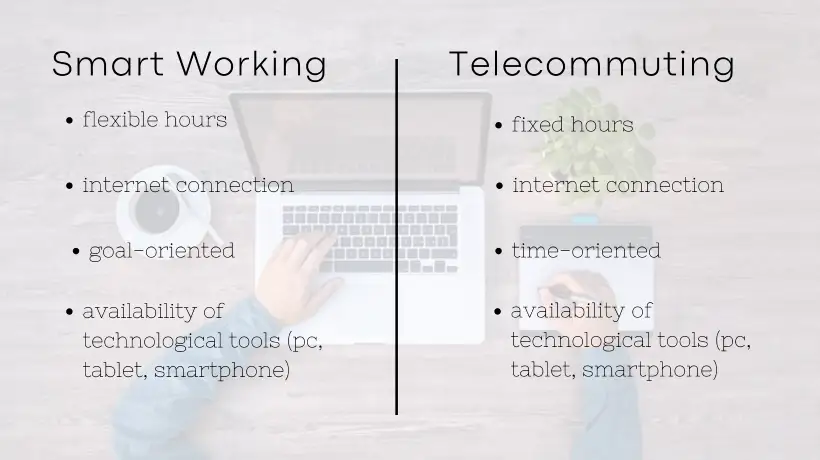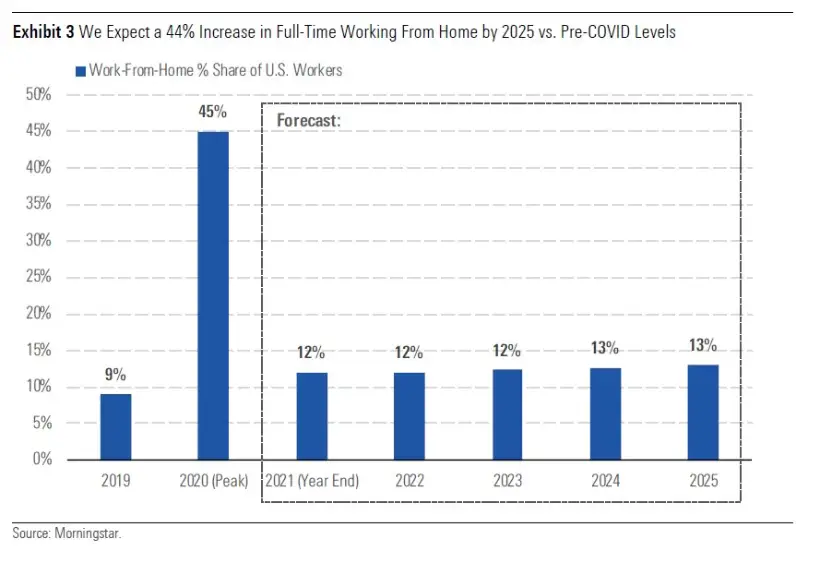
SMART WORKING TELECOMMUTING - With the restrictions due to the pandemic from Covid-19 came forcefully into our lives the term smart working. In Italy, however, the term smart working is - in most cases - incorrectly used to indicate what in reality is telecommuting. In the reality of things, however, in Italy and abroad both ways of enjoying work are widespread. However, there are different regulations, benefits and risks that involve them. There are also several economic implications now and in the future.
The terms telework and smart working do not indicate the same way to enjoy work. This is also clear from the definition of agile work, the smart working note, which is given in the Italian legal system:
«a procedure for the performance of the employment relationship established by agreement between the parties, including forms of organisation by stages, cycles and objectives and without specific constraints on time or place of work, with the possible use of technological tools for carrying out work.»
This definition allows us to understand how agile work is characterized by the fact that the work performance is carried out without a fixed workstation: therefore partly inside the company premises and partly outside. It should therefore not be confused with teleworking, where the employee typically works from home and there is usually only one return to the traditional workplace per week. In teleworking, the worker is bound to work from home but retains the same responsibilities as those who carry out their activities in the workplace. The worker who is in smart working according to the Italian Law n. 81/2017 carries out his activity in three ways:
What all three methods have in common is that it is up to the worker to manage his working day. That is: with the employer - when there is - the objectives and the projects to be carried out and the deadlines within which they must be completed are agreed. It is then up to the worker himself to decide when and how to carry out the work, provided that he completes the objectives within the prescribed period. In telecommuting, instead, employees are required to carry out their activities from home, but exactly as if they were in the office. The two modes are distinct but could also be carried out in a mixed manner, with days when the worker is in smart working and others instead in telework or office. However, this must be agreed between employees and employers.

Recent research has shown the advantages of agile work not only as a barrier aimed at preserving social distance but above all from the point of view of production, sustainability and economics. But there are also risks. It is obvious, however, that we must always consider individual cases, because the benefits (or disadvantages) of working remotely also depend on the individual characteristics: we must always identify what works best for each person.
A recent study conducted by the University of Stanford and based on data collected over three years of observation that involved 250 people operating in 21 companies, small and large, reports the following average data per employee in smart working: 2,400 kilometers traveled less, seven days earned and 270 kilos of carbon dioxide not put into the air with a saving of about 1300 euros per employee. Moreover a search of Confesercenti - lead in Italy - asserts that if smart working became structural, the enterprises could save 12,5 billion the year.
Among the benefits of agile work, there is also the possibility of achieving a better balance between working life and private life, since you can organize yourself in terms of time and space for the performance of work, with a consequent decrease in work stress. As shown by the study conducted by the University of Stanford also shows how smart working, but also telework in this case, reduces the time and cost of transport for individual workers. Savings are also there for companies that save on fixed structure costs. It also allows access to a wider pool of workers, since it is also a favourable option for vulnerable groups: mothers, family caregivers of elderly or disabled people, people unable to move, students who can start early to gain experience in the working environment.
Distance and agile work can introduce risks such as: reduced ability to transfer information between the workforce, the social isolation of the worker and the difficulty of separating personal and working life
According to research carried out by nordvpn in May 2020, one of the main risks of working from home is the involuntary increase in working hours at the expense of workers. Nordvpn has shown that working from home has had a negative impact on the amount of daily working hours of all those American employees forced to work from home during quarantine, planned by the US government to try to contain and stem COVID-19. According to the research, in fact, the working day, when carried out from home, is 40% longer than the office: the hours worked in fact become 11, 3 more than those usually provided.
In Italy at the end of 2019, only 3.6% of those employed between 15 and 64 years of age usually worked from home. During the pandemic of COVID-19 the first data collected give us the possibility to estimate a dizzying growth of this percentage up to peaks between 45% and 50% of employees in Italy.
In 2017 Italy was last in Europe preceded by Greece, Czech Republic, Poland, Slovakia and Hungary. Only 7% of workers had access to smart working, even if only occasionally. Since it accounted for only 1% of general teleworkers. In the European Union the average was around 17% and saw Denmark at the top of the ranking of smart workers with 37% tied with the United States. Positive data also exists in Japan and Brazil where telework and smart working is encouraged to reduce building spaces in cities and the time of transfer between home and workplace.

In 2021, research carried out by the Smart Working Observatory of the School of Management of the Politecnico di Milano showed that the number of smart workers decreased from 5.37 million in the first quarter of the year to 4.07 million in the third quarter. In September there were a total of 1.77 million agile workers in large companies, 630 thousand in SMEs, 810 thousand in micro-enterprises and 860 thousand in the PA. Structured or informal smart working projects are present in 81% of large companies (against 65% in 2019), in 53% of SMEs (in 2019 they were 30%) and in 67% of PAs (against 23% pre-Covid). For the future, instead, smart working will remain or will be introduced in 89% of large companies, in 62% of PAs and in 35% of SMEs. In small and medium-sized enterprises, however, there is a strong tendency to go back, as a third of those who have experienced it plan to abandon smart working. Although about 58% of companies said they had difficulty hiring or retaining employees if smart working or teleworking is not guaranteed.
A recent survey of more than 10,000 US-based offices found that nearly 20% of American employees return to telework one day a week, about 10% two days a week, only 5% three days a week. A percentage is still four or five days and over 50% only occasionally. As for smart working instead:
"We estimate that 45% of Americans worked from home during the pandemic," says Preston Caldwell, senior economic analyst at Morningstar. "But we do not think it will become the new normal. By 2025, we predict that 13% of American workers will work from home full-time, an increase of 44% over 2019".
In France, a study by the Centre d'analyse stratégique says that the number of teleworkers rose from 8.4% in 2009 to 25% between March and April 2020. Different international research reveals that many currently want to keep one or more days of telecommuting during the week. Many currently are considering leaving their apartment in the city center for a country house.
The results of a survey carried out by the Bass Institute show that over 65,000 French cross-border commuters employed by companies located in the Jura Arc (cantons of Vaud, Neuchâtel, Jura and Bern) were home working in February 2022. From the first of July instead the norm has returned in force for which the limit of working hours carried out from house is equal to 25%. But you work to raise the limit to 40%.
In Spain in 2019, telework affected only about 4.8% of the employed population. In less than a month since the start of the pandemic, this mode has affected 16.2%. At the exit from the emergency there is a strong tendency to the survival of some forms of telework and a decisive structural legislative intervention on telework has been carried out. This would establish a kind of hybrid smart working that provides at least 30% of the working day outside the office and the remaining in presence.
The trend in the rest of Europe and the world is very similar to that of the countries mentioned above. In general, companies and workers aim to maintain smart working and telework in the future but aim at a hybrid form that includes days in the office.
READ ALSO ---> The reason why big brands decide to go virtual

Viola Meacci, student of Biomedical Engineering at the University of Pisa, has always been interested in the world of journalism. In her job, she explored the world of blockchain, cryptocurrencies, NFT and metaverse which she now very is passionate about it .





